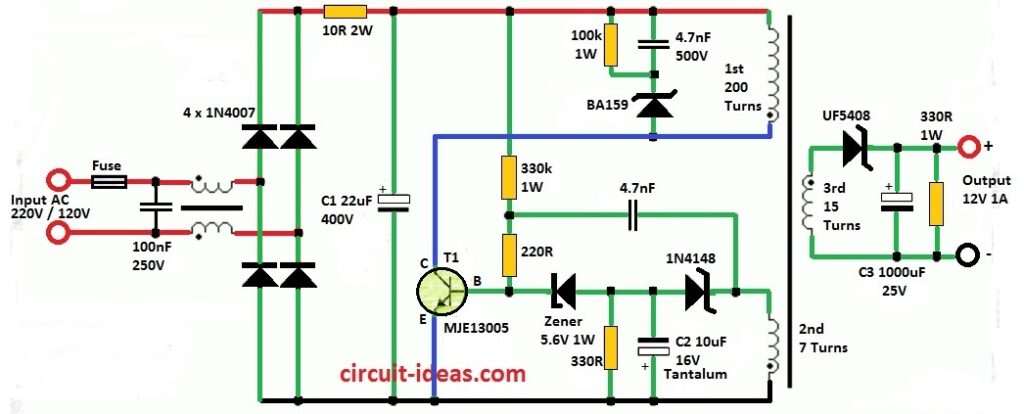This article shows you how to build a simple power supply circuit that plugs into the wall outlet 220V and uses only one transistor MJE13005.
It does not need any fancy chips or extra parts to control the power.
Instead of those parts it uses a special diode and a winding on the transformer to indirectly control the voltage output.
This keeps the voltage from getting too high.
What is a 220V SMPS Circuit:
A 220V SMPS Switched Mode Power Supply circuit is designed to convert a 220V AC alternating current input voltage into a stable DC direct current output voltage.
SMPS circuits are widely used in various electronic devices such as computers, LED drivers and other electronic equipment to provide a regulated and efficient power supply.
Circuit Working:

Parts List:
| Component Type | Description | Quantity |
|---|---|---|
| Resistors | ||
| 10Ω 2W MFR | 1 | |
| 330k 1W MFR | 1 | |
| 220Ω 1/4 W MFR | 1 | |
| 330Ω 1/4 W MFR | 1 | |
| 100k 1W MFR | 1 | |
| 330Ω 1W MFR | 1 | |
| Capacitors | ||
| Electrolytic 22μF 400V | 1 | |
| Electrolytic 1000μF 25V | 1 | |
| Tantalum 10μF 16V | 1 | |
| PPC 4.7nF | 1 | |
| PPC 4.7nF 500V | 1 | |
| PPC 100nF 250V | 1 | |
| Semiconductors | ||
| Diode 1N4007 | 4 | |
| Diode BA159 | 1 | |
| Diode 1N4148 | 1 | |
| Diode UF5408 | 1 | |
| Zener diode 5.6V / 1W | 1 | |
| Transistor MJE13005 | 1 | |
| Fuse | 1 |
Transformer Winding Details:
Use a small EE ferrite core transformer with a central pillar having a cross section of 4.5 x 4.5 mm and an air gap of 0.4 mm.
This core can be sourced from the auxiliary transformer of an ATX power supply.
Wind 1st primary winding with 200 turns of a 0.12 mm diameter wire.
Wind the first half of the primary with 100 turns followed by a thick layer of insulation.
After 100 turns in the same direction finish the second half of the primary 1st by adding the third secondary winding, another heavy layer of insulation and the auxiliary winding which has a second thinner layer of insulation.
Formula for transformer winding:
In a 220V SMPS circuit the primary winding Np of a transformer is calculated as follows:
Np = ( Vin(nom) x 108 ) / ( 4 x f x Bmax x Ae )
where:
- Vin(nom) is a nominal input voltage from 220V RMS where you need to account for peak voltage as well
- f is switching frequency in Hz a common range for SMPS circuits is 50kHz to 200kHz
- Bmax is the maximum flux density in the transformer core in gauss which has typical range is 1200 to 2000 gauss
- Ae is the effective cross sectional area of the transformer core in cm² which is found in the datasheet of your chosen core
Transistor and Diode Placement:
Connect the transistor T1 to the primary winding and ensure proper insulation.
Place the zener diode to regulate the base current of T1.
For small voltages (6V or less) use a schottky diode, otherwise use a fast diode for higher voltages.
Capacitor Installation:
Connect capacitors according to the circuit design with emphasis on polarity.
C2 is crucial for voltage regulation deriving the output voltage indirectly.
Resistor Connection:
Add resistors into the circuit as specified ensuring the correct values are used.
Insulation Layers:
Use insulation layers between windings to prevent short circuits and ensure safety.
Output Voltage Adjustment:
By adjusting the number of turns in the third secondary winding you can change the output voltage.
When calculating the correct output voltage take into account the voltage loss across diode D1.
Testing:
Check for connectivity and correct wiring with a multimeter.
Use power with caution keeping an eye on the output voltage to make sure it is at the appropriate level.
Heat Sink Addition Optional:
If aiming for higher power output attach a heat sink to the transistor T1 to dissipate heat effectively.
Transistor Selection:
If you do not get MJE13005 then you can choose a transistor for T1 with Ucb = 800V and Uce = 450V or higher.
Transistors options include KSC5027, 2SC3150, 2SC3457, 2SC2979, 2SC2866 or BUT11AF which are economically available.
Output Voltage Adjustment:
Adjust the output voltage by changing the number of turns in the secondary winding 3rd with approximately 1.17 turns/V.
Account for the voltage drop across diode D1 while calculating the required output voltage.
Diode Selection:
For small voltages approximately 6V or less replace diode D1 with a schottky diode rated at 40V or higher.
Caution and Warning:
Beginners are not advised to use this switching supply circuit because of involvement of deadly mains voltage.
Extreme caution is needed since poor design could cause mains voltage to reach the output.
Even when a capacitor is unplugged from the mains it may still hold hazardous voltages.
All activities related to this project are undertaken at the individuals own risk and the writer is not responsible for any harm to health or property.
Conclusion:
By following the above methods the users can create a unique and efficient self oscillating.
Simple 220V SMPS Circuit using One Transistor with adjustable output voltage avoids the complexities of integrated circuits and optocouplers.
Leave a Reply